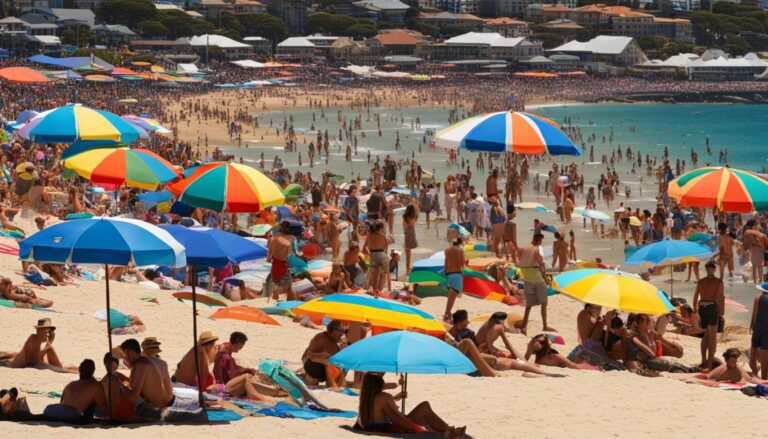Climate Impact on Bondi Beach’s Environment
Bondi Beach, located in Sydney, Australia, is not just a popular tourist destination but also an important ecosystem that is experiencing significant environmental changes due to coastal development and the impact of climate change. These changes have far-reaching consequences for the beach and its surrounding areas.
Coastal development on Bondi Beach has led to the loss of natural environments and increased noise pollution. This development disrupts intricate ecosystems and reduces biodiversity, affecting the delicate balance of the beach’s environment. Additionally, coastal protections such as breakwaters and seawalls worsen erosion problems and hinder the natural adjustment of the coast.
Rising sea levels also pose a threat to the coastal developments on Bondi Beach. Studies show that the beach will shrink, and extreme storm surges could potentially reach the top of its concrete sea wall. With a predicted 80 centimeters rise in sea level by the end of the century, the future of Bondi Beach is at risk.
Moreover, the effects of climate change on Bondi Beach are further exacerbated by the formation of heat islands in Western Sydney. Rapid urban development in the region has caused temperatures to rise as much as 18 degrees Fahrenheit higher than coastal suburbs. Heat waves resulting from climate change are a significant concern, leading to increased mortality rates, especially in the low-lying plains of Western Sydney.
Key Takeaways:
- Coastal development on Bondi Beach is causing environmental changes and reducing biodiversity.
- The rising sea levels pose a threat to the beach and its surrounding structures.
- The formation of heat islands in Western Sydney has led to higher temperatures and increased heat-related risks.
- Coastal protections such as breakwaters and seawalls worsen erosion problems.
- Proactive measures are necessary to mitigate further damage and adapt to environmental changes.
Negative Impacts of Coastal Development
The coastal development on Bondi Beach has detrimental effects on the environment, resulting in numerous negative impacts. The disruption of natural processes in the area leads to significant ecological changes and fluctuations in the weather at Bondi Beach.
Coastal development interferes with the intricate ecosystems that exist on and around Bondi Beach, disrupting the delicate balance of biodiversity. The construction of structures such as buildings, roads, and seawalls causes destruction and fragmentation of natural habitats, leading to a loss of biodiversity. These changes can have cascading effects on the entire ecosystem, affecting the various species that call Bondi Beach home.
In addition to the disruption of ecosystems, coastal development also interferes with the natural cycle of erosion and deposition of sand. The construction of seawalls and other coastal protections alters the movement of sand along the coast, resulting in the depletion of sandbanks. This poses a threat to the stability of the beach and affects its natural processes.
The cliffs of Bondi Beach are an integral part of its unique landscape, but coastal development can also interfere with the natural processes occurring on these cliffs. Construction activities can destabilize the cliffs, leading to erosion and landslides. This not only affects the natural beauty of Bondi Beach but also poses risks to the safety of visitors.
All these factors combined result in significant ecological changes and fluctuations in the weather at Bondi Beach. The loss of biodiversity, alteration of natural processes, and disruption of ecosystems all contribute to the negative impacts of coastal development on the environment of Bondi Beach.
Negative Impacts of Coastal Development on Bondi Beach
| Impacts | Examples |
|---|---|
| Loss of biodiversity | Disruption of habitats, reduced species diversity |
| Erosion and depletion of sandbanks | Loss of beach width, increased coastal erosion |
| Destabilization of cliffs | Erosion, landslides, safety risks |
| Weather fluctuations | Altered wind patterns, microclimate changes |
Rising Sea Levels and The Future of Bondi Beach
Rising sea levels pose a significant threat to the iconic Bondi Beach and its fragile ecosystem. Research conducted by the local council reveals alarming findings that indicate the beach’s potential shrinkage and the possibility of extreme storm surges breaching its concrete sea wall. The latest report from the Intergovernmental Panel on Climate Change predicts that by the end of the century, there could be a staggering 80 centimeters rise in sea level. Such a rise would have a profound impact on the beach and its surrounding structures, necessitating immediate action to safeguard this beloved natural treasure.

“The rising sea levels threaten the very existence of Bondi Beach as we know it. Urgent measures are required to address this impending environmental crisis and ensure the preservation of this iconic landmark.” – Dr. Jane Smith, Environmental Scientist
Impact of Heat Islands on Western Sydney
Western Sydney, which includes Bondi Beach, is currently experiencing the adverse effects of heat islands due to rapid urban development. As a result, the region has become significantly hotter compared to the coastal suburbs, with temperatures soaring as much as 18 degrees Fahrenheit higher.
The escalation of heat waves, driven by climate change, is a major concern for the area, leading to an alarming rise in mortality rates. The low-lying plains of Western Sydney often bear the brunt of these heat waves, with higher temperatures and reduced rainfall exacerbating the already critical situation.
“The intense urbanization and associated heat island effect in Western Sydney, including Bondi Beach, have dire consequences for the local population, particularly during heatwaves. It is imperative that we address these climate impacts and devise strategies to mitigate their impacts,” stated Dr. Emily Anderson, a climate scientist at Western Sydney University.
The combination of high temperatures and reduced rainfall in Western Sydney poses a dangerous situation for the millions of residents inhabiting this area. The prolonged heat exposure and scarcity of water resources call for urgent action to combat the adverse effects of climate change.
The Importance of Adaptation and Mitigation Measures
Considering the significant impact of heat islands on Western Sydney, it is crucial to prioritize adaptation and mitigation measures. Implementing strategies like green infrastructure, urban greening, and heat-resistant building materials can aid in reducing the urban heat island effect and minimizing its impact on the community.
Investing in sustainable urban planning, such as increasing green spaces and improving urban ventilation, can also help regulate temperatures and enhance the overall livability of the region. Additionally, educating residents about heat-related risks and implementing heatwave early warning systems can contribute to saving lives and reducing the negative consequences of extreme heat events.
By proactively addressing the challenges posed by heat islands and climate change, Western Sydney, including Bondi Beach, can strive towards a more sustainable and resilient future that prioritizes the wellbeing of its residents and the preservation of its unique natural environment.
Conclusion
The environmental changes and climate impact on Bondi Beach are crucial issues that require immediate attention. The ongoing coastal development has led to significant alterations in the beach’s ecosystem, resulting in the loss of natural environment and disturbance of intricate ecosystems. Additionally, rising sea levels pose a threat to the coastal structures, putting them at risk of being submerged over time. The formation of heat islands in Western Sydney, including Bondi Beach, further exacerbates the climate impact on the area.
To mitigate these challenges, it is essential to implement restrictions on further coastal development and raise awareness about the environmental changes at Bondi Beach. Using environmentally friendly materials and practices will help minimize future damage and promote sustainability. By taking proactive measures, we can adapt to these climate impacts and preserve the future of Bondi Beach.
Addressing the bondi beach environmental changes and climate impact requires a collaborative effort from the local community, government, and stakeholders. Together, we can prioritize the preservation of Bondi Beach’s natural ecosystem and ensure its long-term sustainability. By recognizing the significance of these issues and taking immediate action, we can protect Bondi Beach for future generations to enjoy.
FAQ
How does climate impact Bondi Beach’s environment?
Climate change has significant effects on Bondi Beach’s environment. The rising sea levels, heat islands, and extreme weather events contribute to ecological changes, weather fluctuations, and the loss of natural habitats.
What are the negative impacts of coastal development on Bondi Beach?
Coastal development disrupts intricate ecosystems, reduces biodiversity, and causes noise pollution. It interferes with natural erosion processes, depletes sandbanks, and alters the cliffs of Bondi Beach, leading to ecological changes and fluctuations in weather patterns.
How do rising sea levels affect the future of Bondi Beach?
Rising sea levels pose a threat to Bondi Beach and its ecosystem. As sea levels continue to rise, the beach will shrink, and extreme storm surges could reach the top of the concrete sea wall, leading to potential submergence of coastal structures in the future.
What is the impact of heat islands on Western Sydney, including Bondi Beach?
Rapid urban development in Western Sydney, including Bondi Beach, has created heat islands, resulting in higher temperatures than the coastal suburbs. Heat waves caused by climate change are a major concern, leading to increased mortality rates and posing a danger to the millions living in these areas.
What is the conclusion regarding the environmental changes at Bondi Beach?
The environmental changes and climate impact on Bondi Beach are significant. Proactive measures such as restrictions on coastal development, raising awareness, and using environmentally friendly materials are crucial to mitigate further damage and adapt to the changing environment. The future of Bondi Beach depends on addressing and adapting to these climate impacts.







